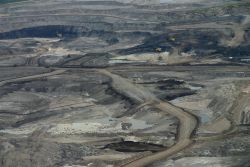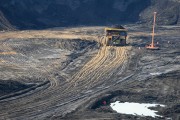The recent wave of instability in the Middle East and the corresponding increase in oil prices have refuelled the debate in Washington, D.C. over the role Canada's oil should play in meeting American energy demand.
Earlier today, U.S. President Barack Obama delivered a speech focusing on America's energy security, and his bottom line was this:
"The only way for America's energy supply to be truly secure is by permanently reducing our dependence on oil. We have to find ways to boost our efficiency so that we use less oil. We have to discover and produce cleaner, renewable sources of energy with less of the carbon pollution that threatens our climate. And we have to do it quickly."
We've heard similar statements before from the U.S. President in support of clean energy, but this speech makes the connection between using less oil and increasing energy security crystal clear (you can find more details in this White House backgrounder on energy security).
 The timing of Obama's remarks is also significant. The Republican-led U.S. House of Representatives Subcommittee on the Western Hemisphere is holding a hearing tomorrow on "Rising oil prices and dependence on hostile regimes: The urgent case for Canadian oil." The hearing is set against the backdrop of a much broader debate around whether Canada's oilsands could provide energy security to the United States.
The timing of Obama's remarks is also significant. The Republican-led U.S. House of Representatives Subcommittee on the Western Hemisphere is holding a hearing tomorrow on "Rising oil prices and dependence on hostile regimes: The urgent case for Canadian oil." The hearing is set against the backdrop of a much broader debate around whether Canada's oilsands could provide energy security to the United States.
The title of hearing suggests the Republican leadership have their minds made up. But a look behind the curtain suggests that the issue of energy security is more complex. In fact, our analysis suggests there can be unexpected negative consequences to increasing U.S. energy reliance on oilsands.
Before we can have an informed discussion about energy security, however, we must begin by understanding how different groups use the term energy security.
Many definitions of energy security
If you look, you will find there are as many definitions as there are voices in the debate.
Oilsands proponents like the Canadian Association of Petroleum Producers like to define energy security narrowly as providing a safe, secure source of oil from a friendly nation. The Government of Alberta takes a similar tack arguing oilsands can "further enhance U.S. security by reducing imports from less secure and reliable sources."
Meanwhile, the Council on Foreign Relations considers price volatility, vulnerability to supply disruptions, and whether oil revenues empower U.S. adversaries like Iran or Venezuela. For its part, the Chamber of Commerce considers 37 indicators in four broad categories (geopolitical, economic, reliability, and environmental).
And then there are those who, like Obama, argue "energy security" is really about reducing the need for energy. For example, the Natural Resources Defense Council talks about reducing U.S. dependence on oil through energy efficiency, raising fuel economy standards, and increased reliance on renewable energy sources.
A false sense of security?
 Probably the best definition comes from the International Energy Agency (IEA), one of the world's most respected organizations tracking energy issues. The IEA defines energy security as a function of three things: where the energy comes from, what it costs and its level of environmental impact. From this perspective, oilsands arguably fails on two of the three criteria.
Probably the best definition comes from the International Energy Agency (IEA), one of the world's most respected organizations tracking energy issues. The IEA defines energy security as a function of three things: where the energy comes from, what it costs and its level of environmental impact. From this perspective, oilsands arguably fails on two of the three criteria.
1. Oilsands come from Canada — a conflict-free and friendly nation.
2. Oilsands require high gas prices to make development cost-effective, and are therefore not able to address price volatility.
3. Oilsands come with a high environmental impact that is currently not being properly managed, and development produces higher greenhouse gas emissions than conventional fuels.
Let's take a closer look at these items, one by one.
Source of supply
There is no doubt Canada is a stable country and a strong ally of the United States. Oilsands proponents tend to argue that sourcing oil from Canada is considerably better than some of the alternatives — namely countries like Iran and Venezuela, where oil revenues may be used to support terrorist activity or regimes with poor human rights records.
But even if the U.S. reduces its reliance on oil from adversarial governments to instead buy more from Canada's oilsands, that doesn't automatically mean that other oil-producing nations will produce less oil or bring in fewer profits. The world's oil markets dictate who gets what oil, and who profits most. So a shift in U.S. demand simply means that "unfriendly" countries will sell their oil to other markets, and profit accordingly.
The Council on Foreign Relations confirms this assessment. While CFR argues that importing oilsands to the U.S. could possibly help divert revenues away from adversarial governments "because oil is essentially traded on a global market, [the security benefits of oilsands are] not as large as some might intuitively assume. Oilsands exploitation will not fundamentally change the global oil picture."
Another U.S. think tank, the Truman National Security Project, has raised concerns that U.S. reliance on foreign oil was helping to enrich hostile governments, fund terrorist organizations and prop up repressive regimes. But the group stops short of suggesting Canada is a better alternative, stating: "Buying from friendly or domestic sources does not solve our problem, because the countries with the greatest reserves — notably, Saudi Arabia — are such major producers that they set the global supply....By staying addicted to oil, regardless of where we purchase it, we give OPEC countries the power to cripple our economy and bring America to its knees."
Canada's poor policy record
The above considerations really only look at political stability, whereas when it comes to making multi-billion-dollar investment decisions, there's also the question of policy stability. On that front, Canada fairs poorly.
Despite continued promises to implement a national approach to reducing greenhouse gas pollution, Canada's federal government continues to drag its feet — leaving a patchwork of provincial climate policies and lingering uncertainty about when and how a federal system might be implemented. Within Alberta, persistent mismanagement and policy half-measures mean that companies must also consider the prospect of changing and increasingly stringent regulations addressing regional environmental impacts to air quality, wildlife habitat and water.
The world's most expensive oil?
When talking about the economics of the oilsands, one thing remains constant. You need high oil prices for the oilsands to be economically viable. It is one of the most expensive barrels of oil produced on the world market.
If the U.S. wants to import more oilsands, Americans will have to get used to higher gas prices. Interestingly, this is certain to happen if the Keystone XL pipeline is approved.
At a certain point, the high price of oil makes oilsands development less attractive than investing in alternatives like increased energy efficiency and renewable sources.Because global oil prices are projected to stay high and even increase, the oilsands may not be the chosen energy source. High oil prices actually result in more investments in energy efficiency and renewable energy — eroding the demand and supply base for oil. The Cambridge Energy Research Associates (CERA), identified an oil price "break-point" of $120-150 per barrel, where the demand for oil decreases in favour of other alternatives like energy efficiency and renewables.
In other words, oil prices need to stay high to make a profit ($65-95) but not climb so high as to reduce oil demand or stimulate substitution by competing fuels.
Organizations like Oil Change International argue that Canadian oil imports do not insulate the U.S. from oil price volatility. "The U.S. already imports over 2 million barrels a day from Canada. It did not protect us from rising prices in 2008, it hasn't this time, and it never will," the group said in a recent statement. They point to the fact that Middle Eastern countries through their conglomerate OPEC have 76 per cent of proven global oil reserves and will continue to control the market no matter how much Canadian oil is produced.
Environmental risks
Finally, oilsands production creates many environmental risks, which are not being managed properly by either the federal or provincial governments, as the Royal Society of Canada recently observed. This is true whether talking about mining or in situ (drilling) production:
- Oilsand mining requires substantial amounts of water, while in situ drilling is projected to have major impacts to groundwater.
- Oilsands mining also creates massive tailings ponds that cover an area the size of Washington D.C. with major financial legacy.
- While mining operations are set to disturb an area more than 1.5 times the size of Yosemite National Park, in situ operations will disturb an area much larger (6,500 square kilometers, or 1.6 million acres).
Climate change implications
The global issue of climate change is clearly one of intense interest to the United States. U.S. military leaders have observed that America's national security hinges more on climate change than other factors.
Likewise, the IEA has stated that if the world were to continue to track energy use as it has in the past, we would lose climate security. It is now broadly recognized in the military, environmental and climate science communities (among others) that climate change is a destabilizing global force that could undermine the economy and the environment and lead to military conflict.
The IEA confirmed in a report that if fossil-energy consumption continues as projected without any changes in policies, it "takes us inexorably towards a long-term concentration of greenhouse gases in the atmosphere in excess of 1000 parts per million of carbon dioxide equivalent. The carbon dioxide concentration implied by the reference scenario would result in the global average temperature rising by up to 6°C. This would lead almost certainly to massive climatic change and irreparable damage to the planet."
In other words, increasing the world's reliance oilsands, a fuel with very high greenhouse gas intensity, is not consistent with addressing global climate change. In fact, oilsands in situ operations — which are set to overtake mining — are very greenhouse gas-intensive with two and half times more greenhouse gas emissions per barrel than mining operations. Both forms of oilsands production are more greenhouse gas-intensive than conventional oil.
The Government of Canada has not published information on the fate of the oilsands under a serious regulatory regime that would actually need to be implemented to either meet Canada's Copenhagen commitments, or deeper reductions in line with what climate science says is required. But the Pembina Institute and David Suzuki Foundation did complete this work in 2010, and not surprisingly, the oilsands would be required to grow at a slower rate under these scenarios.
In other words, the rate of oilsands expansion currently on the books is not consistent with "walking the talk" on addressing climate change. So from impacts to emissions, the oilsands fail the energy security test on environmental grounds.
Decreasing our reliance on oil
The route to energy security for the U.S. — and in Canada — is to fully commit to develop low-carbon domestic alternatives to expensive and risky foreign oil of all kinds.
In the wake of the BP oil spill last summer, my colleague Cherise Burda released an analysis suggesting that decreasing our reliance on oil in Ontario would not only increase Ontario's energy security but help keep money in the province and improve residents' quality of life. The Natural Resources Defense Council in the United States has put together plans outlining solutions to America's oil dependency.
But it's not just about using less oil. As my colleague Clare Demerse demonstrated in a recent Pembina report, there are greater opportunities for job growth by increasing clean energy investments than in other sectors. "In light of the superior job and climate performance of clean energy over fossil fuels," she writes government can take action to maximize its green job potential by, "directing public dollars away from support to fossil fuels and towards core climate change solutions such as energy conservation, energy efficiency and renewable energy."
It is seductive to think the oilsands can address the United States' energy needs, but the evidence is clear — the oilsands are a route towards higher impact, more expensive oil. As noted Canadian economist Jeff Rubin puts it, "You know you are at the bottom of the ninth when you are schlepping a tonne of sand to get a barrel of oil."






